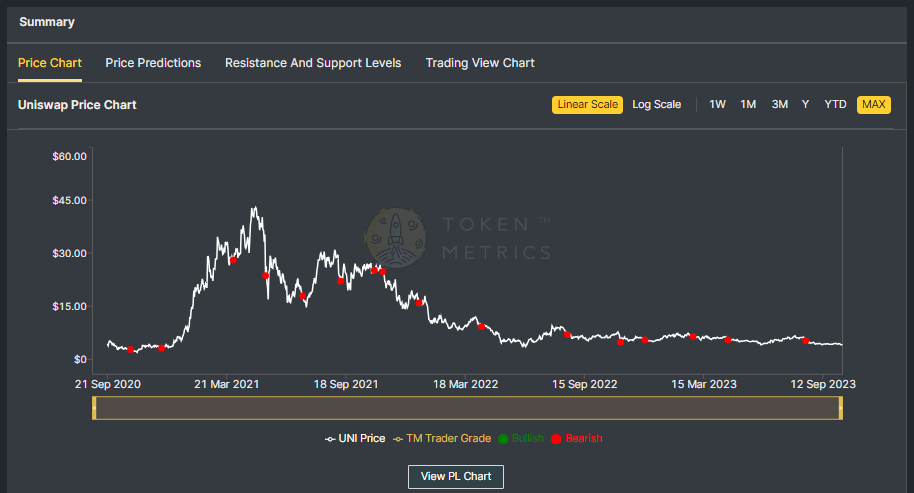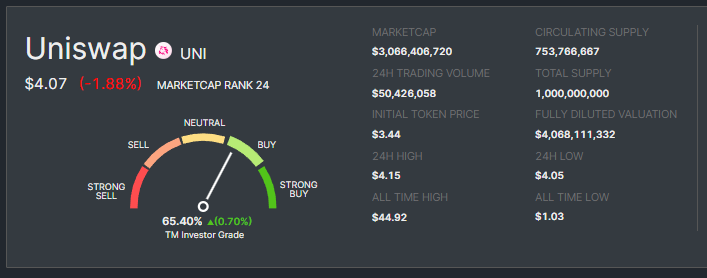How Token Metrics Spotted HYPE Before the Breakout — And Why It Matters for Every Crypto Trader

The crypto market has been a rollercoaster lately.
Bitcoin is dipping. Altcoins are bleeding. Sentiment across the board is skittish. Fear is gripping retail traders — and in times like these, many are unsure where to turn, what to buy, or when to hold back.
But not everyone’s losing.
Some traders are still finding wins. One example? Hyperliquid (HYPE) — a standout performer in April 2025. And here’s the kicker: Token Metrics called the move before it happened.
While most traders were distracted by meme coins or frozen in fear, Token Metrics users were riding a +51.8% breakout, armed with AI-driven insights and data-backed confidence. This blog breaks down what happened, how Token Metrics spotted the trade before the crowd, and what tools you can use today to find the next HYPE-level breakout before it happens.
The Hyperliquid Surge: What Happened?
On April 14, while much of Crypto Twitter was silent on HYPE, Token Metrics issued a bullish signal on the token. The platform’s AI-powered Trader Grade identified a strong setup forming — based on technical indicators, rising volume, and early momentum shifts.
That signal marked the beginning of a +51.8% price surge, which saw HYPE peak at $38.50 before a broad market correction pulled it back to ~$32.40.
Even with the correction, traders who acted on the early signal locked in solid profits, exited smart, or are now watching for the next move with eyes wide open — guided by grades, not guesswork.
Why Token Metrics Got It Right — When Others Missed It
While most platforms react to price action after it happens, Token Metrics is built to anticipate movement before it’s obvious. Here’s how:
✅ Technical Momentum Detection
The Trader Grade analyzes short-term price action, RSI trends, MACD crossovers, breakout patterns, and dozens of other technical indicators. HYPE’s chart showed tightening consolidation and rising buy volume — and TM’s systems flagged it in real time.
✅ Volume Spike Recognition
One of the earliest clues in any breakout is an uptick in volume. Token Metrics identifies surging liquidity that precedes breakouts — something that traditional screeners miss or catch late.
✅ Narrative Tracking
Hyperliquid was part of a subtle but growing "on-chain perpetuals" narrative — a theme most traders weren’t tracking yet. TM’s AI-powered narrative filters helped surface HYPE as an early player in a trending category.
✅ Signal Strength Confidence
Token Metrics doesn’t just throw out signals randomly. The platform assigns confidence scores based on data quality, historical performance, and AI pattern recognition. HYPE didn’t just look good — it looked statistically strong.
Current Situation: Pullback or Setup?
After topping at $38.50, HYPE retraced — now sitting about 15.8% below its high. Some might see weakness. But Token Metrics helps traders read beyond the price:
- 📈 Trader Grade still says “Buy” — meaning short-to-mid-term bullish momentum is intact.
- 🟡 Investor Grade is Neutral — a smart, cautious stance until more long-term data emerges.
- 🔍 Key Level: $32 — this is the zone bulls need to defend to keep the trend alive.
This context is what makes Token Metrics invaluable. While the crowd panics, TM users stay informed, balanced, and ready.
Token Metrics in Action: Trading with Data, Not Emotion
Let’s zoom out. Why does this matter for your trading journey?
Most traders operate on emotion, social media chatter, or FOMO. Token Metrics flips that model on its head — giving you a complete data-driven crypto trading toolkit:
🧠 AI-Powered Trader Grades
These grades score tokens on a 0–100 scale based on short-term technical momentum. A Trader Grade above 80 often precedes a strong move — as seen with HYPE.
📊 Investor Grades for Long-Term Confidence
Built from 80+ on-chain and off-chain data points — including liquidity, tokenomics, VC backers, exchange listings, community engagement, and developer activity.
📈 Real-Time Market Signals
Get alerted when a new bullish or bearish signal is triggered. These alerts are based on pattern recognition, performance history, and current price action.
🌐 Narrative Filters
Narratives drive price — from DeFi Summer to AI Agent tokens. TM helps you stay on top of evolving themes and find the tokens leading those trends early.
🔔 Alerts & Watchlists
Set custom alerts for grade movements, bold signals, or top gainer movements — so you never miss a trade even when you’re not glued to the screen.
Key Trading Benefits of Using Token Metrics
Let’s break it down: Why use Token Metrics instead of trading blindly?
1. Spot Breakouts Early
Tools like the Market Page and Top Gainers tab help you spot tokens heating up — before they explode. You won’t be the one buying at the top anymore.
2. Avoid FOMO and Bad Buys
TM’s objective grades help filter out low-quality tokens. You can avoid chasing scams or hype-based pumps with no foundation.
3. Simplify Your Research
Instead of spending hours flipping through charts and Twitter threads, Token Metrics gives you instant, high-signal data — all in one place.
4. Trade With Confidence
Whether you’re swing trading or building a long-term bag, the Trader and Investor Grades help validate (or invalidate) your bias.
5. Stay Ahead of Market Rotations
The crypto market rotates fast. Token Metrics surfaces where capital is flowing — and which narratives are gaining strength — so you can rotate with it.
What to Do Next: Trade the Signal, Not the Crowd
Looking ahead, HYPE’s next move depends on what happens at the $32 support zone:
- ✅ If it holds: there’s room for upside continuation. The Trader Grade supports it.
- ❌ If it breaks: eyes shift to $25 — a critical support where new buyers may step in.
Either way, Token Metrics users won’t be guessing. They’ll wait for the next signal — bullish or bearish — and make calculated moves based on real data.
This is the difference between reactive trading and strategic trading.
Final Takeaway: Token Metrics Helps You Trade Smarter, Not Harder
The HYPE breakout wasn’t luck. It was the result of acting on strong, data-backed signals before the crowd caught on.
If you’re tired of chasing pumps, panicking in drawdowns, or wondering why others always seem to find winners early, then it's time to level up.
With Token Metrics, you can:
- 🔍 Spot early movers like HYPE
- 📊 Trade with AI-powered confidence
- 📈 Get in before the trend — and exit before the crash
- 🧠 Make every trade a calculated decision
Ready to Catch the Next HYPE?
Join thousands of traders using Token Metrics to find breakout tokens before they pump.
👉 Explore the platform now at tokenmetrics.com
👉 Get real-time signals, bold alerts, and daily data updates
👉 Trade with structure — not speculation
Because in crypto, the edge goes to the trader with information, not emotion.
Create Your Free Token Metrics Account

.png)




%201.svg)
%201.svg)


%201.svg)












.svg)




.png)